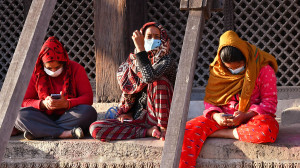National
Monsoon brings mushroom poisoning among the poor
Dozens die every year in Nepal after eating wild mushrooms. Experts say deaths are preventable through awareness and action.
Post Report
A few days ago, two girls aged 22 and 17 from a village in ward 5 of Mangsebung Rural Municipality in Ilam district died after eating wild mushrooms. Another man from the same area was hospitalised after consuming mushrooms collected from a nearby jungle.
With the monsoon just around the corner, experts warn that cases of wild mushroom poisoning and resulting death spike during the season.
The pre-monsoon rainfall has created moist conditions ideal for the growth of mushrooms in forests. Working-class people, especially those residing in rural areas who go into forests for fodder and firewood, are highly vulnerable to being affected by wild mushroom consumption.
“The chance of getting seriously ill or dying from wild mushroom consumption is 50-50,” said Dr Rakesh Ghimire, assistant professor at the Institute of Medicine, Tribhuvan University. “So it is better not to consume wild mushrooms. The risk of misidentification of wild mushrooms remains very high, as both edible and non-edible mushrooms look almost similar.”
Studies have found that there are 1,291 species of wild mushrooms in Nepal, and over 100 species are poisonous.
It has been reported that the victims in Ilam suffered from abdominal pain, vomiting, diarrhoea, and seizures following the consumption of poisonous mushrooms.
Doctors say that, along with abdominal pain, vomiting, diarrhoea, and seizures, victims also suffered from hallucinations and renal failure. In severe cases, victims suffered from liver failure and died.
“Don’t wait for the symptoms to get cured at home if you have vomiting or abdominal cramps after eating mushrooms collected from forests,” said Ghimire. “Seek immediate treatment at the nearest health facility. Delayed treatment increases the risk of fatality.”
The outcome of the problems depends on the toxicity of the mushrooms, the amount consumed, and the quality of medical care. Victims whose health conditions are serious need to be referred to advanced health facilities in big cities.
Experts say the toxins of poisonous mushrooms are heat-resistant and hence, do not neutralise even after cooking.
“Better not to consume toxic mushrooms altogether,” said Ghimire, faculty of the Clinical Pharmacology Department, which runs the Poison Information Centre at the Tribhuvan University Teaching Hospital. “Go to the hospital if you have consumed a wild mushroom and have suffered from adverse effects. Health workers can also contact our hotline number—014502011—if they need any expert help for case management.”
Experts say 30 to 35 people die each year due to wild mushroom poisoning. The actual number of mushroom poisonings and deaths could be much higher, as many such incidents go unnoticed or underreported.
They say that wild mushroom poisoning is neglected by health authorities in the country even as hundreds of people get affected from it every year, and dozens die. The issue has neither been a priority for the media nor the concerned authorities, as victims are generally poor people from marginalised communities, say experts.
“Due to extreme poverty in some communities, people eat wild mushrooms out of compulsion,” said Dr Hari Prasad Aryal, a mushroom expert. “They would rather risk death by eating than die of hunger.”
Experts say one should not consume any wild mushroom unless they are certain that it is edible. Colourful mushrooms have a higher chance of being toxic than others. Study shows mushrooms have a strong capacity to absorb potentially toxic elements including hydrocarbons, mercury, and lead from contaminated soil. Even mushroom species that were considered edible and consumed in the past could be poisonous due to contamination of soil with heavy metals, according to experts.
Launching a campaign to make people aware of the risk of consuming wild mushrooms could lessen mushroom poisoning incidents. Using mass media and teaching about the dangers in schools would be effective in reducing the consumption of toxic mushrooms, according to experts.
“Along with launching awareness among vulnerable populations, authorities must find out the underlying reasons why people consume wild mushrooms from which they could die,” said Aryal. “If people are made aware of risks, and provided alternatives such as livelihood opportunities, incidents of wild mushroom consumption will come down.”




 9.12°C Kathmandu
9.12°C Kathmandu












%20(1).jpg&w=300&height=200)

